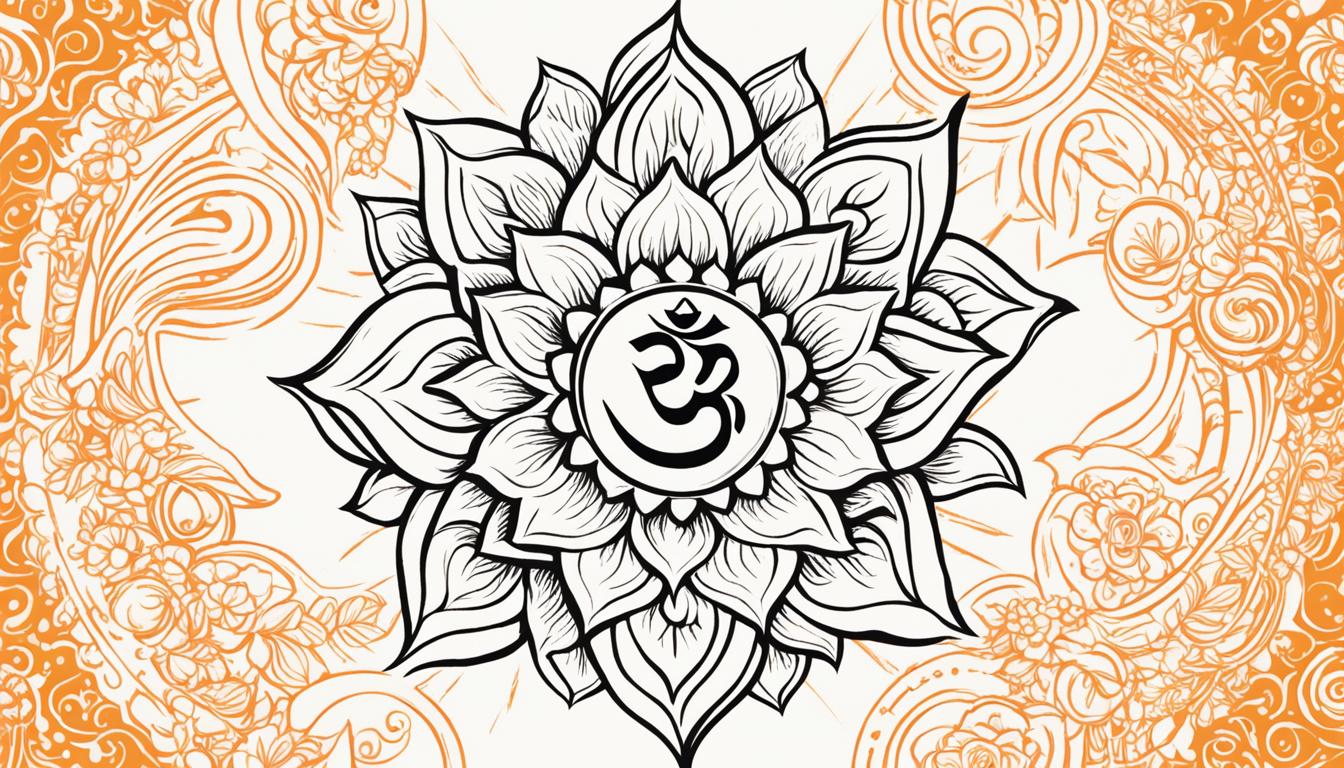Have you ever wondered about the similarities between Hinduism and Buddhism? These two ancient religions share a long history and have profound connections that may surprise you. While they have distinct beliefs and practices, they also have commonalities that reveal a deeper unity. So, what are the shared aspects of Hinduism and Buddhism that bridge these two spiritual paths?
Key Takeaways
- Hinduism and Buddhism share common beliefs and practices despite their differences.
- Both religions recognize karma and the goal of attaining enlightenment or liberation.
- Both Hinduism and Buddhism place a strong emphasis on meditation as a spiritual practice.
- Both religions teach that the world is an illusion and attachment leads to suffering.
- Hinduism and Buddhism have different views on the concept of the self and the path to liberation.
The Influence of Buddhism: Mindfulness and Compassion
Buddhism’s impact on individuals and society is profound, offering valuable teachings that address modern challenges and promote personal and societal harmony. Two key aspects that highlight Buddhism’s influence are mindfulness and compassion.
Mindfulness, a central practice in Buddhism, involves cultivating a non-judgmental awareness of the present moment. It encourages individuals to observe their thoughts, feelings, and sensations without attachment or aversion. By practicing mindfulness, you can develop a deeper understanding of your own mind and cultivate a sense of inner peace and clarity.

Compassion, referred to as “karuna” in Buddhism, is the desire to alleviate the suffering of others and cultivate a genuine care and empathy for all beings. This practice encourages you to recognize the interconnectedness of all living beings and to extend kindness and compassion towards yourself and others. By embracing compassion, you contribute to creating a more compassionate and harmonious society.
The Power of Mindfulness and Compassion in Addressing Modern Challenges
In today’s fast-paced and stress-filled world, the teachings of Buddhism provide invaluable guidance and practices to navigate the challenges of modern life. By integrating mindfulness and compassion into your daily life, you can:
- Reduce stress and improve overall well-being
- Enhance focus, attention, and productivity
- Cultivate healthier relationships and enhance social interactions
- Develop empathy and understanding towards diverse perspectives
- Promote personal growth and self-awareness
- Address societal issues such as inequality, violence, and environmental degradation with empathy and compassion
Mindfulness and compassion not only benefit individuals but also contribute to building a more compassionate and harmonious society. When you cultivate these qualities within yourself, you create a ripple effect, inspiring others to do the same and fostering a collective shift towards greater empathy, understanding, and positive change.
| Benefits of Mindfulness | Benefits of Compassion |
|---|---|
| Reduces stress and anxiety | Promotes empathy and understanding |
| Enhances focus and attention | Fosters healthier relationships |
| Improves emotional well-being | Contributes to societal harmony |
| Increases self-awareness | Encourages acts of kindness and altruism |
Meditation: A Common Spiritual Practice
Both Hinduism and Buddhism recognize meditation as a powerful spiritual practice that leads to enlightenment and liberation. In both traditions, meditation is considered a pathway to quieting the mind, overcoming attachment, and gaining profound spiritual insight.
While there are differences in the specific practices and techniques of meditation between Hinduism and Buddhism, the underlying goal remains the same – to attain a state of higher consciousness and liberation from the cycle of rebirth and suffering.
In Hinduism, meditation, known as Dhyana, is one of the key practices to attain Moksha, the liberation from the cycle of life and death. It involves focused concentration and mindfulness, allowing individuals to delve deeper into their inner selves and connect with the divine. Through meditation, practitioners seek to realize the true nature of their existence and ultimately merge with the divine.
In Buddhism, meditation is practiced to reach Nirvana, a state of liberation from suffering and the attainment of ultimate truth. One of the most well-known forms of meditation in Buddhism is mindfulness meditation, where individuals cultivate present-moment awareness and non-judgmental acceptance of their thoughts, feelings, and sensations.

Meditation in both Hinduism and Buddhism goes beyond the physical act of sitting in stillness. It is a transformative practice that allows individuals to cultivate inner peace, clarity, and compassion. Through meditation, practitioners develop a deeper understanding of themselves and the world around them, leading to personal growth and spiritual awakening.
The Similarities in Hinduism and Buddhism Meditation Practices:
| Hinduism | Buddhism |
|---|---|
| Meditation as a means to attain Moksha | Meditation as a way to reach Nirvana |
| Focus on concentration and mindfulness | Emphasis on mindfulness and present-moment awareness |
| Quietening the mind and overcoming attachment | Cultivating non-judgmental acceptance and compassion |
| Seeking union with the divine | Achieving liberation from suffering |
Despite the slight differences in techniques and goals, the practice of meditation unites Hinduism and Buddhism. Both traditions recognize the transformative power of meditation in deepening spiritual connection, gaining insights, and attaining liberation. It is a shared spiritual practice that offers individuals a path to enlightenment and a way to transcend the limitations of the ego and find inner peace.
The Illusion of the World: Maya and Avidya
Hinduism and Buddhism both recognize the illusionary nature of the world, emphasizing the concept that everything we perceive is not as it seems. In Hinduism, this illusory nature is referred to as Maya, while in Buddhism, it is known as Avidya. Both religions acknowledge the impermanence of worldly experiences and the suffering that arises from attachment to them.
The concept of Maya in Hinduism teaches that the world we perceive is a manifestation of the divine, yet it is also illusory. The illusion lies in the attachment to material possessions, desires, and ego, which distract us from the true nature of reality. Overcoming Maya is seen as essential for spiritual awakening and liberation from suffering.
Avidya in Buddhism also emphasizes the illusory nature of the world. It is the fundamental ignorance that blinds us to the true reality of existence. Avidya leads to attachment and craving, which ultimately causes suffering. The goal in Buddhism is to overcome Avidya through spiritual practices such as meditation and insight, leading to the realization of the impermanence of all phenomena.

The Illusion of Impermanence
Central to both Maya and Avidya is the recognition of the impermanence of all things. Hinduism and Buddhism acknowledge that everything in the world is in a constant state of flux. By clinging to transient experiences and possessions, we set ourselves up for disappointment and suffering. Understanding the impermanent nature of reality allows us to let go of attachments and find lasting peace.
| Hinduism (Maya) | Buddhism (Avidya) |
|---|---|
| Believes in the ultimate reality of Brahman, the divine unity | Rejects the existence of a permanent or independent self |
| Emphasizes the illusory nature of the material world | Focuses on the illusory nature of all phenomena |
| Seeks liberation through realizing the true self beyond illusion | Seeks liberation by realizing the impermanence of all phenomena |
The Notion of the Self: Ahamkara and Anatta
Hinduism and Buddhism offer contrasting perspectives on the concept of the self. In Hinduism, the self, also known as the ego, is referred to as Ahamkara. This notion of the self is considered a hindrance to spiritual realization and enlightenment. The ultimate goal in Hinduism is to transcend the ego and recognize the true self, which is pure and divine.
On the other hand, Buddhism challenges the idea of a permanent and independent self through the concept of Anatta. In Buddhism, the self is seen as an illusion, devoid of any inherent existence. The aim is to realize that there is no separate and enduring self, thereby letting go of attachment to this notion. By freeing oneself from the illusion of self, one can achieve liberation and spiritual awakening.
The difference in perspective between Hinduism and Buddhism regarding the self reflects their distinct approaches to spiritual realization and the path to enlightenment. While Hinduism emphasizes the transcendence of the ego to reach the true self, Buddhism advocates for the realization that there is no permanent and independent self to begin with.
Image:

The Path to Liberation: Karma and Dharma
In the journey toward spiritual liberation, both Hinduism and Buddhism emphasize the significance of karma and dharma. Karma, the law of cause and effect, dictates that our actions in this life shape our future lives. Every thought, word, and deed carries consequences that will ultimately determine our path to liberation. By cultivating mindfulness and making conscious choices, you can shape your own destiny and pave the way for a more enlightened existence.
According to Hinduism, dharma refers to the righteous duties and obligations that each individual must fulfill in order to lead a virtuous life. Dharma provides a moral compass, guiding individuals to act in accordance with cosmic order and harmony. By embracing their righteous duties, individuals not only contribute to the well-being of society but also progress on their path to spiritual liberation.
In Buddhism, dharma encompasses the teachings of the Buddha and the path to enlightenment. By following the noble eightfold path, which includes principles such as right understanding, intention, speech, action, livelihood, effort, mindfulness, and concentration, individuals can cultivate virtues and break free from the cycle of suffering.
In both Hinduism and Buddhism, engaging in good deeds and righteous duties is considered fundamental to the path of liberation. By practicing compassion, kindness, and selflessness, individuals accumulate positive karma, which propels them closer to liberation. These acts of selflessness not only benefit the individual but also contribute to the betterment of the world at large.
| Karma | Dharma |
|---|---|
| Refers to the law of cause and effect | Encompasses righteous duties and obligations |
| Actions in this life determine future lives | Guides individuals towards leading a virtuous life |
| Influenced by thoughts, words, and deeds | Contributes to cosmic order and harmony |
| Engaging in good deeds accumulates positive karma | Helps individuals progress on their path to liberation |
The Goal of Enlightenment: Nirvana and Moksha
Both Hinduism and Buddhism share the ultimate goal of attaining enlightenment and escaping the cycle of rebirth. In Hinduism, this state of liberation is known as Moksha, where the individual unites with the divine and achieves the ultimate truth. Similarly, Buddhism aims to reach Nirvana, a state of liberation from suffering and the realization of the ultimate truth. Both religions emphasize transcending desires and attachments to attain these enlightened states.
Enlightenment, whether it is called Moksha or Nirvana, represents the pinnacle of spiritual growth and understanding. It is the state where one gains profound insights into the nature of existence and the ultimate truth that lies beyond worldly illusions. This pursuit of enlightenment involves rigorous self-discipline, intense meditation, and a deep commitment to self-transformation.
Within the teachings of Hinduism and Buddhism, enlightenment is not merely an abstract concept but a tangible and achievable goal for every individual. It is a state of supreme bliss, peace, and liberation from the cycle of suffering. The enlightened individual transcends the limitations of the ego and experiences a profound sense of unity with all beings and the universe.
Reaching Enlightenment: Paths and Practices
While Hinduism and Buddhism share the common goal of enlightenment, they offer distinct paths and practices to achieve it. In Hinduism, the path to Moksha encompasses various Yogic practices, such as Jnana Yoga (the path of knowledge), Bhakti Yoga (the path of devotion), Karma Yoga (the path of selfless action), and Raja Yoga (the path of meditation and control of the mind). Each path is tailored to meet the unique spiritual needs and inclinations of individuals.
Buddhism, on the other hand, emphasizes the Noble Eightfold Path as the means to attain Nirvana. This path includes elements such as right understanding, right thought, right speech, right action, right livelihood, right effort, right mindfulness, and right concentration. By following this path, individuals cultivate wisdom, morality, and mental discipline, leading them closer to the ultimate goal of liberation.
Despite their different approaches, both Hinduism and Buddhism recognize the transformative power of meditation as a means to achieve enlightenment. Meditation quiets the mind, purifies the soul, and allows individuals to transcend the limitations of the ego and connect with the deeper reality that underlies all existence.
Unlocking the Door to Liberation
The journey towards enlightenment, whether in Hinduism or Buddhism, is a profound undertaking that demands self-reflection, self-discipline, and continual spiritual growth. It requires individuals to question their attachments, desires, and illusions, and to strive for self-transcendence.
By pursuing the goal of enlightenment and working towards liberation, individuals in both Hinduism and Buddhism find meaning, purpose, and fulfillment in life. The journey towards spiritual awakening becomes a deeply transformative and empowering experience, guiding them towards the ultimate truth and liberation from suffering.
Conclusion
The similarities between Hinduism and Buddhism reveal a profound connection between two of the world’s ancient religions. These commonalities, including shared beliefs, spiritual practices, and the pursuit of liberation, bridge the gap between these two traditions. By recognizing the parallels between Hinduism and Buddhism, individuals can gain valuable insights into personal and societal harmony, as well as guidance for leading a virtuous and fulfilling life.
Both Hinduism and Buddhism emphasize the importance of karma, or the law of cause and effect, in shaping one’s destiny. Additionally, meditation serves as a powerful spiritual practice in both traditions, allowing individuals to quiet the mind and gain deeper insights. These shared aspects provide pathways to achieving spiritual liberation and breaking free from the cycle of rebirth and suffering.
While Hinduism and Buddhism have distinct differences, such as their views on the self and the goal of enlightenment, the connections between these two religions highlight the unity and interconnectedness of all spiritual paths. By recognizing the shared principles of Hinduism and Buddhism, individuals can cultivate a greater understanding and appreciation of the diverse ways in which individuals seek spiritual growth and liberation.
FAQ
What are the similarities between Hinduism and Buddhism?
Hinduism and Buddhism share common beliefs and practices, such as the recognition of karma and the goal of attaining enlightenment or liberation. Both religions also emphasize the importance of meditation as a spiritual practice.
How has Buddhism influenced mindfulness and compassion?
Buddhism has had a significant impact on promoting mindfulness and compassion. The teachings of Buddhism offer insights into achieving personal and societal harmony through practices such as mindfulness meditation and cultivating compassion for all beings.
Is meditation a common spiritual practice in Hinduism and Buddhism?
Yes, both Hinduism and Buddhism place a strong emphasis on meditation as a means to achieve enlightenment or liberation. In Hinduism, meditation, known as Dhyana, is a way to attain Moksha, while in Buddhism, meditation is practiced to reach Nirvana.
What is the concept of the illusion of the world in Hinduism and Buddhism?
Both Hinduism and Buddhism teach that the world is an illusion. In Hinduism, this illusion is known as Maya, while in Buddhism, it is referred to as Avidya. Both religions emphasize the impermanence of everything in the world and the suffering caused by attachment to worldly desires.
How do Hinduism and Buddhism view the concept of the self?
In Hinduism, the self, or ego, is called Ahamkara and is considered a hindrance to spiritual realization. In Buddhism, the concept of self, or Anatta, is seen as an illusion. The goal in both religions is to transcend the ego or realize the absence of a permanent, independent self.
What role do karma and dharma play in Hinduism and Buddhism?
Both Hinduism and Buddhism recognize the importance of karma and dharma in the path to liberation. Karma refers to the law of cause and effect, where one’s actions determine their future lives. Dharma, on the other hand, refers to the righteous duties and obligations one must fulfill to lead a virtuous life.
What is the goal of enlightenment in Hinduism and Buddhism?
The goal in both Hinduism and Buddhism is to attain enlightenment and liberation from the cycle of rebirth. In Hinduism, this state of liberation is known as Moksha, where one unites with the divine and achieves ultimate truth. In Buddhism, the goal is to attain Nirvana, a state of liberation from suffering and the ultimate truth.
What do the similarities between Hinduism and Buddhism signify?
The profound similarities between Hinduism and Buddhism highlight the unity and interconnectedness of all spiritual paths. They provide insights into personal and societal harmony, offer guidance for leading a virtuous and fulfilling life, and underscore the shared beliefs and practices that bridge these two ancient religions.

